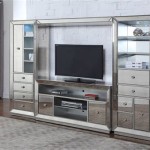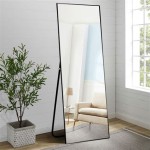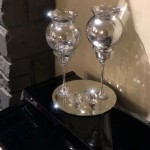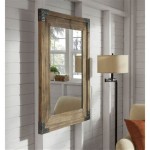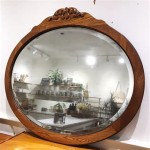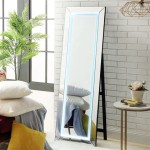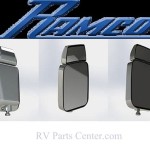Mounting a Mirror on Drywall: A Comprehensive Guide
Mirrors add a touch of elegance and spaciousness to any room. Whether it's a full-length mirror in your bedroom or a decorative mirror in your living room, hanging them securely on your drywall is essential. Drywall, a common wall covering, presents unique challenges for hanging heavy items, but with the right tools and techniques, you can successfully mount a mirror without fear of it falling.
Understanding Drywall Construction
Drywall is essentially a thin sheet of gypsum board covered with paper. It's lightweight and relatively easy to work with, but it's not as strong as traditional plaster or concrete walls. This means you'll need to use the right anchors to support the weight of your mirror. Drywall is typically attached to wall studs, which are vertical wooden or metal supports that run through the wall. The studs provide structural support and are your best bet for mounting heavy objects. However, there are also times when you may need to mount your mirror between studs, which requires a different approach.
Choosing the Right Mounting Method
The method you choose to mount your mirror on drywall depends heavily on the mirror's size and weight. These are the most common methods:
1. Using a Drywall Anchor
Drywall anchors are small plastic or metal devices that expand inside the drywall to create a secure hold. They are ideal for lighter mirrors, and are easy to install.
- Types of Drywall Anchors: There are various types of drywall anchors, each with its own advantages:
- Plastic anchors are generally suitable for lighter loads and available in various sizes.
- Metal anchors are stronger and offer more support for heavier objects. They can be further divided into toggle anchors and molly bolts, each with its own mechanism.
- Installation: To use a drywall anchor, you need to drill a pilot hole that is slightly smaller than the anchor's diameter. Insert the anchor into the hole and use a screwdriver or hammer to drive it flush with the wall. This causes the anchor to expand, firmly gripping the drywall.
- Advantages: Drywall anchors are economical, readily available, and easy to install, even for novice DIYers. They are minimally invasive and do not leave large holes in the drywall.
- Disadvantages: Drywall anchors are not suitable for extremely heavy mirrors. They may also weaken over time, especially if you are repeatedly removing and reinstalling the mirror.
2. Using a Toggle Bolt
Toggle bolts are used for mounting heavy objects on drywall and are ideal for situations where you can't reach a wall stud. They are designed to expand when turned, providing a secure grip.
- Installation: Unlike drywall anchors, toggle bolts require a larger hole in the drywall. The hole should be wide enough to accommodate the bolt and the wings of the toggle. After drilling the hole, insert the toggle bolt and, using a screwdriver or wrench, turn it clockwise until the wings open and secure the bolt.
- Advantages: Toggle bolts are designed for heavy objects and offer much more holding strength than drywall anchors. They are versatile and can be used in situations where finding a stud is difficult.
- Disadvantages: Toggle bolts require a larger hole in the drywall, making them less suitable for smaller mirrors. Installation can also be slightly more challenging than using drywall anchors.
3. Using a Wall Stud
Attaching a mirror directly to a wall stud provides the strongest and most secure mounting method. While it requires more work, it is the best solution for heavy mirrors.
- Finding the Stud: You can use a stud finder to locate the stud behind the drywall. Alternatively, you can tap the wall lightly. You will hear a solid, distinct sound when you hit a stud, as opposed to the hollow sound of drywall.
- Drilling: Once you have found the stud, drill a pilot hole that is slightly smaller than the screw size. Use a drill bit designed for wood to ensure a clean hole.
- Advantages: Mounting a mirror directly to a stud is the most secure method and minimizes the risk of the mirror falling. It allows you to use standard screws, which are generally more durable than anchor systems.
- Disadvantages: Requires finding a stud, which may not always be possible, especially in locations with tight spaces.
Essential Tools and Materials
You'll need a few essential tools and materials before you begin mounting your mirror:
- Level: To ensure your mirror hangs straight.
- Pencil: For marking the mirror's placement on the wall.
- Stud finder: To locate the wall studs.
- Drill: With a drill bit size suitable for the chosen anchor or screws.
- Screwdriver: To tighten screws.
- Measuring tape: To determine the height and width of the mirror.
- Drywall anchors: If you are not using a wall stud.
- Toggle bolts: For heavier mirrors or when mounting between studs.
- Screws: The size and type of screws you need will depend on the mirror's weight and the mounting method you choose.

How To Hang A Heavy Mirror On Drywall Stas Picture Hanging Systems
How To Hang A 100 Pound Mirror On Drywall Quora

Mounting A Mirror On Drywall Top 8 Ways For Savvy Handyman

How To Hang A Large Or Heavy Mirror

How To Hang A Heavy Mirror

How To Hang A Heavy Mirror Diy Family Handyman

How To Hang A Heavy Mirror

How To Hang A Heavy Mirror With French Cleat

How To Hang Heavy Mirrors Frames Without Nails 3m

How To Hang A Very Heavy Picture Or Mirror The Best

